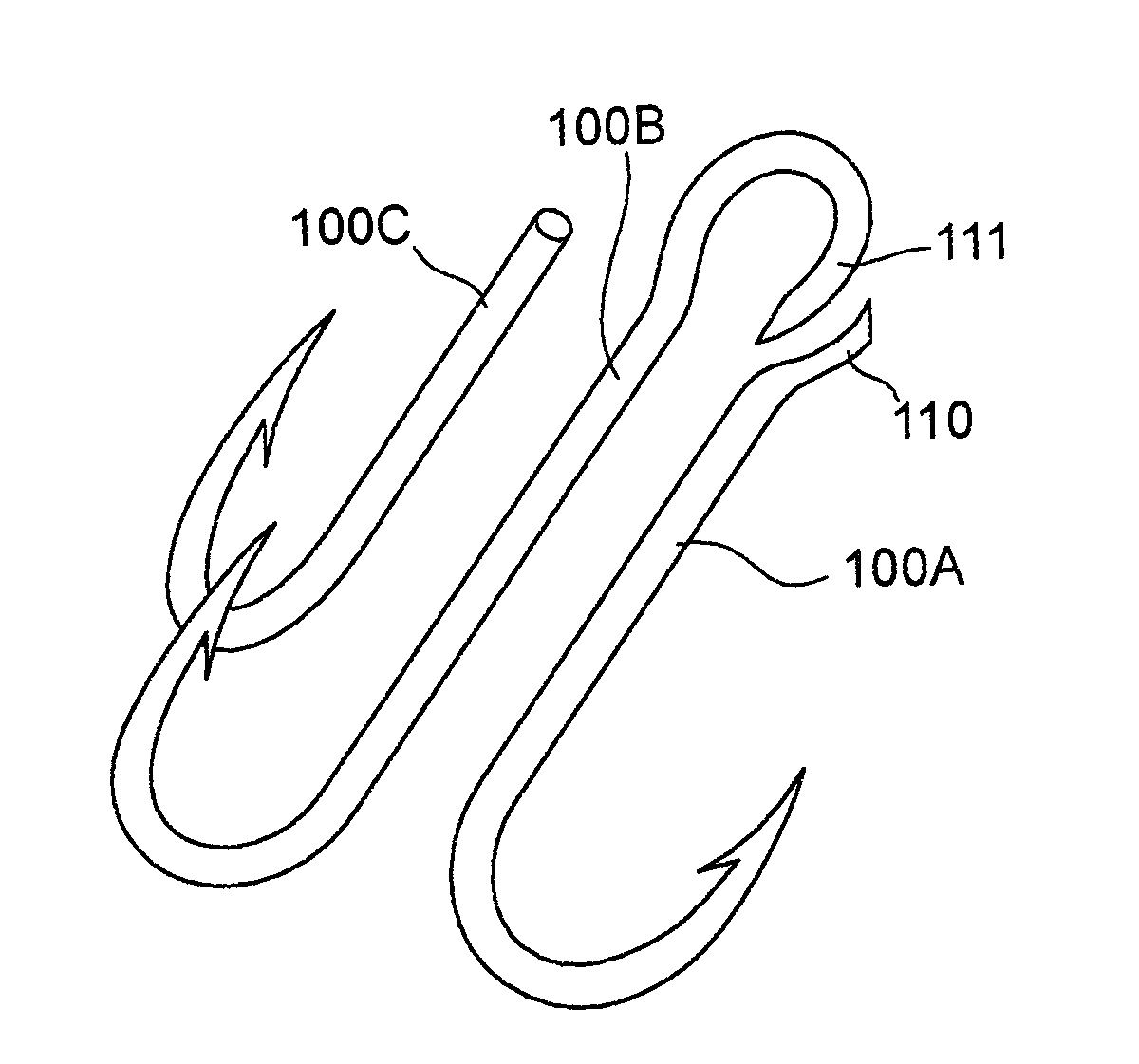This, in conjunction with the small size makes split rings difficult and tedious to open for attaching and detaching a fish hook.
Additionally, the sharp points of the fish hook often pierce the anglers hand while struggling with the procedure.
The process of attaching and detaching the fish hook to and from a
split ring is well known by anglers as being exceptionally challenging even with the use of special purpose pliers.
Dependent on an angler's physical abilities and dexterity, attaching and detaching a fish hook to and from a split ring is, in some cases, virtually impossible.
Attaching a split ring to a
fishing lure connection ring is equally as difficult.
It is well known by anglers that fishing lures inevitably become entangled with each other when stored in fishing tackle boxes due to the attached fish hooks.
Fish hooks remain attached to fishing lures after use as removal is impractical.
Generally, the task of removing fish hooks from fishing lures is limited to replacement of damaged hooks.
Time required to remove hooks from a hooked fish and extent of manhandling by the angler affects fish mortality.
In many cases, the released fish dies because of excessive handling during removal of the hook, thereby defeating intentions.
Barbless hooks tend to cause less trauma to the fish during extraction which provides a greater probability of fish survival following release but it is not always desirable to utilize barbless hooks unless mandated by fish and game authorities since the angler becomes exposed to a trophy fish getting unhooked during the landing process.
The open eye design provides ease of connection but is prone to unintentional detachment.
The designs as claimed are not accommodative for application on conventional treble hooks having three welded together shanks and / or are not conducive to attachment directly onto fishing lure spoons without employment of a split ring since the inturned guard portion will not, in many cases, feed through the hole of the trailing end of fishing lure spoons and / or will potentially damage the finish on the fishing lure spoon while attempting to
mount the device.
The double shank formation is not accommodative for application thereof to conventional single wire fish hook eyes or to treble hooks.
Furthermore, the design negates attachment of the device directly onto a fishing lure spoon.
One shank being free of the other shanks weakens the device compared to conventional treble hooks having 3 welded together shanks and as such, it is prone to bending when attempting to extract the fish hook from a fish using a device such as
needle nose pliers.
Further, the device is not accommodative to detachment from a fishing lure when the point of free shank has deeply hooked a fish and the objective is to not extract the fish hook but detach it from the fishing lure and leave it within the fish.
The eye configuration does not alleviate the concerns associated with split ring use nor is it accommodative for convenient detachment of the fish hook from a fishing lure in the case of a deeply hooked fish that is to be released without extracting the fish hook.
Additionally, the device is not conducive to attachment directly onto fishing lure spoons without employment of a split ring.
None of these fish hook devices utilize two elongated shanks suitably joined together along said shanks to form a single fish hook device with a secure clasp eye in the form of a clip nor do they utilize an elongated shank that forms a secure wire locking clasp at its end.
Additionally, these devices are not designed to make the treble hook effectively detachable from a fishing lure where the fish hook is deeply hooked within a fish so as to allow the fish to be released with minimal trauma and hopefully shed the fish hook at some later time.
Further, the fish hook devices seen in the prior art do not offer a pointed clasp eye formation that would allow anglers to utilize the shank as a means for bait attachment.
The device does not alleviate the tedious and difficult task of holding a relatively small split ring and at the same time, forcing the hook eye to wedge open the end of a split ring wire coil.
Prior art has not addressed or provided a marketable solution to the existing and well known problems associated with having to wedge open split rings for attaching and detaching fish hooks to and from fishing lures.
The device is design specific for direct connection of
fishing line and is not accommodative to engagement onto fishing lure connection rings and the like due to the double eye design.
The design, marketed under the name of Spintech Hooks (seen at www.tackletour.com / reviewsintechhooks.
html), places the swiveling component directly atop the shank so it is difficult to attach the device to a split ring since the eye wants to rotate when pressure is applied thereto against said split ring.
There is insufficient space for the angler to hold the eye of the device between
thumb and
index finger so as to keep it from rotating while attempting to
mount the device onto a split ring.
 Login to view more
Login to view more  Login to view more
Login to view more 


